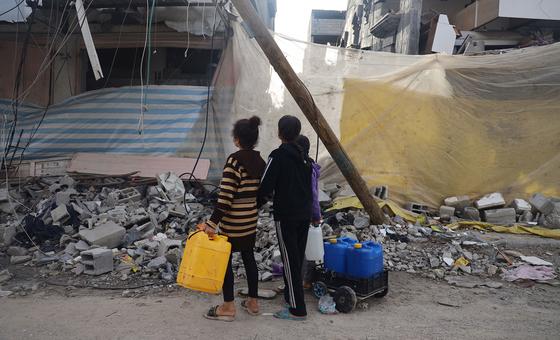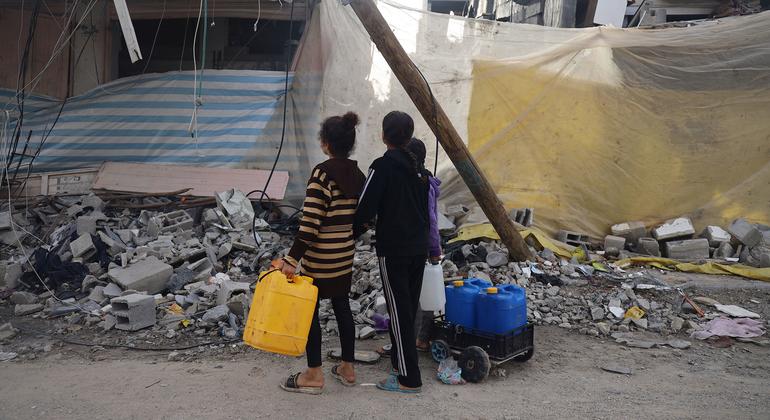
“Access to sufficient amounts of clean water is a matter of life and death…children in Gaza have barely a drop to drink,” said UNICEF Executive Director Catherine Russell. “Children and their families are having to use water from unsafe sources that are highly salinated or polluted. Without safe water, many more children will die from deprivation and disease in the coming days.”
The humanitarian alert came after more than 10 weeks of near-constant bombardment of the enclave in response to Hamas’s terror attacks in southern Israel that killed around 1,200 people and left more than 240 held hostage.
In a bid to escape the bombing which has heavily impacted the Strip’s water production, treatment and distribution networks, more than 1.4 million uprooted Gazans have sought shelter in or near facilities run by the UN agency for Palestinian refugees, UNRWA.
Survival mode
But UNICEF said that recently displaced children in southern Rafah governorate have only 1.5 to two litres of water every day, and that water services were “at the point of collapse”.
“For survival alone, the estimated minimum is three litres per day,” the UN agency said in a statement.
Alarming as the lack of drinking water is, “hundreds of thousands” of displaced people – half of them children – also remain “in desperate need” of food, shelter, medicines and protection, UNICEF stressed.
At least 50 per cent of WASH facilities – providing basic water and sanitation services – have been damaged or destroyed in Gaza, as UNICEF warned that the impact of this situation on children was particularly worrying because they are more susceptible to diarrhoea, disease and malnutrition.
“Already, officials have recorded almost 20 times the monthly average of reported cases of diarrhoea among children under the age of five, in addition to increases of cases of scabies, lice, chicken pox, skin rashes and more than 160,000 cases of acute respiratory infection,” UNICEF reported.
Relief efforts
Since the start of the crisis, UNICEF and partners have provided fuel to operate wells, desalination plants, water trucking and waste and sewage management, along with bottled water and water containers for more than 1.3 million people.
More than 45,000 jerry cans have been distributed along with at least 130,000 family hygiene kits, including menstrual health and hygiene products and hundreds of thousands of bars of soap.
The UN agency underlined the need for generators to operate water and sanitation facilities, along with plastic pipes to fix broken plumbing. But these continue to be blocked from entering Gaza owing to “access restrictions”.
“Constant bombing, restrictions on materials and fuel are preventing critical progress,” UNICEF’s Ms. Russell insisted in a tweet.
First convoy from Jordan
In a related development, the UN World Food Programme (WFP) announced that the first aid convoy from Jordan had reached Gaza after weeks of coordination.
The 46-truck convoy was carrying 750 metric tons of food assistance, the UN agency said, adding that it was hopeful this could lead to “more sustained and scaled-up access” to more vulnerable people.
Push for pause in fighting
The latest humanitarian alert came amid increasing international pressure for a new pause in hostilities in the Gaza Strip, to enable more aid supplies to be trucked in for the most vulnerable.
The first pause lasted from 24 November to 1 December.
UNRWA Commissioner-General Philippe Lazzarini recently warned that desperate people have been “taking the food, and eating it right away”, while social media posts have shown groups of people stopping aid convoys and removing supplies.
“Everywhere you look, is congested with makeshift shelters. Everywhere you go, people are desperate, hungry and terrified,” Mr. Lazzarini told journalists in Geneva.
Citing the Gazan health authorities, UNRWA said in its latest update on the crisis that more than 19,450 Palestinians have been killed in the hostilities according to health authorities and “around 70 per cent are reported to be women and children”.



